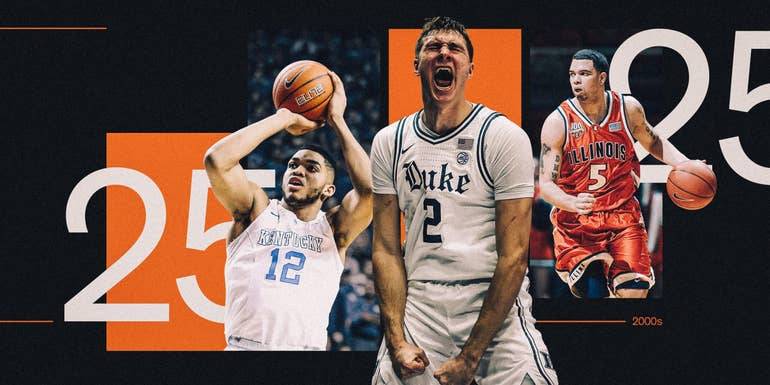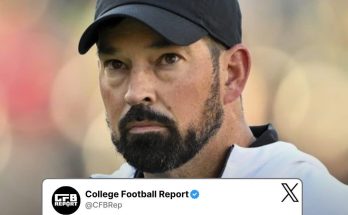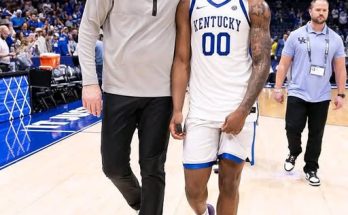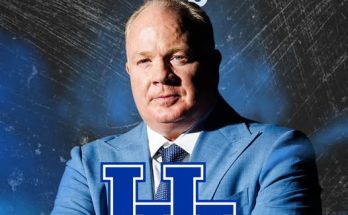**UNFINISHED BUSINESS: Ranking The Top 25 College Hoops Teams Since 2000 That Fell Short of a Title**
The NCAA Tournament is the ultimate proving ground in college basketball, where legacies are cemented by cutting down the nets. But for every champion crowned, there are legendary teams that came agonizingly close—squads loaded with NBA talent, historic dominance, and unforgettable moments that just couldn’t finish the job. These teams left behind legacies of “what if?” and “almost,” their near-misses haunting fans for decades. Here, we rank the top 25 college basketball teams since 2000 that were good enough to win it all but fell short when it mattered most.
At No. 25, the 2021-22 North Carolina Tar Heels authored one of the most surprising March runs in recent memory. First-year coach Hubert Davis took a team that barely made the tournament and turned them into giant slayers, spoiling Mike Krzyzewski’s retirement party by beating Duke in the Final Four. But after leading Kansas by 15 in the national championship game, the Tar Heels collapsed, undone by Armando Bacot’s injury and Brady Manek’s foul trouble. A storybook ending was within reach—until it wasn’t.
The 2013-14 Florida Gators (No. 24) entered the Final Four on a 30-game winning streak, looking like a juggernaut. Billy Donovan’s veteran squad, led by Patric Young and Scottie Wilbekin, had bulldozed through the SEC. But UConn’s Shabazz Napier had other plans, dismantling the Gators in a defensive masterpiece. Florida’s suffocating defense, which had carried them all season, suddenly had no answers.
Bob Huggins’ 2009-10 West Virginia Mountaineers (No. 23) were a tough, physical team built for March. Da’Sean Butler’s heroics carried them past Kentucky in the Elite Eight, but their dream died in the Final Four when Butler crumpled to the floor with a knee injury against Duke. Without their leader, the Mountaineers had no chance against the eventual champs.
Bruce Pearl’s 2018-19 Auburn Tigers (No. 22) were the ultimate underdog story, taking down Kansas, North Carolina, and Kentucky in succession. Jared Harper and Bryce Brown formed one of the nation’s most explosive backcourts, but their magic ran out in the Final Four when a controversial foul sent Virginia to the free-throw line in the closing seconds. The Tigers were seconds away from the title game—until a whistle changed everything.
The 2015-16 North Carolina Tar Heels (No. 21) were a possession away from glory. Marcus Paige’s double-clutch three to force overtime against Villanova is one of the greatest shots in tournament history—but Kris Jenkins’ buzzer-beater one-upped him. Brice Johnson and Joel Berry II led a stacked roster, but destiny belonged to the Wildcats.
Eddie Sutton’s 2003-04 Oklahoma State Cowboys (No. 20) were old-school tough, led by John Lucas III and Tony Allen. They stormed to the Final Four, only to lose on a last-second layup to Georgia Tech. A hair’s breadth separated them from playing for a title.
Butler’s 2010-11 team (No. 19) nearly pulled off back-to-back miracles. Brad Stevens’ Bulldogs, led by Shelvin Mack and Matt Howard, returned to the title game but shot an abysmal 18.8% from the field in a loss to UConn. Sometimes, the magic just runs out.
The 2006-07 Georgetown Hoyas (No. 18) were a throwback to the glory days of Big East basketball. Jeff Green and Roy Hibbert dominated inside, but Ohio State’s Greg Oden and Mike Conley Jr. proved too much in the Final Four.
Bruce Weber’s 2004-05 Illinois Fighting Illini (No. 17) started 29-0, playing a revolutionary brand of up-tempo basketball. Deron Williams, Dee Brown, and Luther Head were unstoppable—until they met North Carolina in the title game. Sean May’s Tar Heels outmuscled them in a classic showdown.
Gonzaga’s 2016-17 team (No. 16) was Mark Few’s best shot at a title before 2021. Nigel Williams-Goss and Zach Collins led the Bulldogs to the championship game, but North Carolina’s experience proved too much. The Zags were right there—just not quite ready.
Frank Kaminsky and Sam Dekker’s 2014-15 Wisconsin Badgers (No. 15) did the unthinkable—they took down undefeated Kentucky in the Final Four. But Duke’s freshman trio (Jahlil Okafor, Justise Winslow, Tyus Jones) outlasted them in the title game. A legendary team that deserved a ring.
John Calipari’s 2007-08 Memphis Tigers (No. 14) were seconds away from a title before Mario Chalmers’ miracle three sent the game to overtime. Derrick Rose and Chris Douglas-Roberts were unstoppable—until free throws (12-of-19 in regulation) doomed them.
The 2019-20 Dayton Flyers (No. 13) never got their shot. Obi Toppin’s high-flying squad was the best team in the country when COVID canceled the tournament. We’ll never know if they could’ve won it all.
T.J. Ford’s 2002-03 Texas Longhorns (No. 12) were a powerhouse, but Carmelo Anthony’s Syracuse team outdueled them in the Final Four. Ford was the nation’s best player—but ‘Melo was unstoppable.
The 2012-13 Michigan Wolverines (No. 11) had Trey Burke’s heroics, Glenn Robinson III’s athleticism, and Nik Stauskas’ shooting. But Louisville’s defense and Luke Hancock’s hot hand denied them in the title game.
Ben Howland’s 2005-06 UCLA Bruins (No. 10) played lockdown defense with Jordan Farmar and Arron Afflalo, but Joakim Noah and Florida overwhelmed them in the championship. The Bruins’ best team since the Wooden era fell just short.
Villanova’s 2017-18 squad (No. 9) was the best team in America—until UMBC shocked the world. Jalen Brunson and Mikal Bridges never got a chance to prove their greatness in the tournament after the first 16-over-1 upset in history.
Anthony Davis’ 2011-12 Kentucky Wildcats (No. 8) were unstoppable—until they met Louisville in the Final Four. A shocking loss for a team that seemed destined to cut down the nets.
Jim Calhoun’s 2008-09 UConn Huskies (No. 7) had Kemba Walker and Hasheem Thabeet but fell to Michigan State in the Final Four. A team with championship talent that couldn’t get over the hump.
The 2000-01 Michigan State Spartans (No. 6), defending champs with Jason Richardson and Zach Randolph, were upset by Arizona in the Final Four. Tom Izzo’s best team outside of 2000 couldn’t repeat.
Gonzaga’s 2020-21 team (No. 5) was one of the most dominant in history—undefeated until Baylor blew them out in the title game. Jalen Suggs and Drew Timme deserved a ring, but the Bears were unstoppable.
Villanova’s 2015 squad (No. 4) was even better than the 2016 title team, but an early upset by NC State kept Ryan Arcidiacono and Josh Hart from their moment.
The 2001-02 Maryland Terrapins (No. 3) won it all in 2002, but their 2001 team—which blew a 22-point lead to Duke in the Final Four—was even more talented. The greatest “what if?” in Terps history.
John Calipari’s 2014-15 Kentucky Wildcats (No. 2) went 38-1, deploying the infamous platoon system with Karl-Anthony Towns, Devin Booker, and Willie Cauley-Stein. But Wisconsin’s Frank Kaminsky and Sam Dekker stunned them in the Final Four. The greatest team to not win it all.
And at No. 1, the 2004-05 North Carolina Tar Heels—wait, no. The *2003-04* Tar Heels. Sean May, Raymond Felton, Rashad McCants, and Marvin Williams made up perhaps the most talented team of the 2000s. They won it all in 2005, but their 2004 squad—which lost to UConn in the Final Four—was even deeper and more explosive. If not for a cold shooting night, they’d be remembered as one of the greatest ever.
These teams remind us that March Madness is as much about heartbreak as triumph. Some were upset, some ran into better teams, and others just had one bad night. But their greatness isn’t diminished by falling short—it’s immortalized in the agony of unfinished business.



